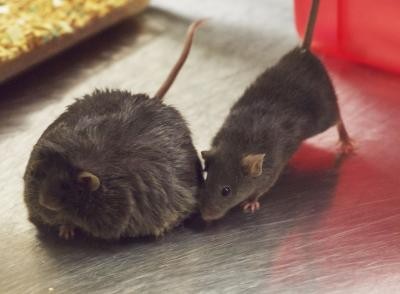Mice and men share a diabetes gene

A joint work by EPFL, ETH Zürich and the CHUV has identified a pathological process that takes place in both mice and humans towards one of the most common diseases that people face in the industrialized world: type 2 diabetes.
This work was conducted in Johan Auwerx's (EPFL) and Ruedi Aebersold's (ETH Zürich) laboratories, and succeeded thanks to the combination of each team's strengths. The relevance of their discovery, published today in Cell Metabolism, results from their joint effort.
In Lausanne, the researchers carried out a detailed study of the genome and the 'phenome' (the set of all phenotypes or clinical features) of a family of mice composed by 183 members. "By comparing the metabolism of twins subjected to different life conditions and with a different diet, it is possible to exactly assess the influence of the environment on the expression of certain genes and the way this affects clinical features and the risk for developing diseases" explained Johan Auwerx, director of the Laboratory of integrative systems physiology (LISP).
Up to this moment, the combination of the genotypic and phenotypic information had already proved to be enlightening. In this instance, researchers added a new analytical "layer" obtained through new spectrometry technology developed at ETH Zürich, making it possible to quantify the presence of hundreds of proteins from a single sample and establish what experts call each individual's "proteome".
By combining each mouse's genome, phenome, proteome and metabolome, the scientists were able to identify a particular gene, located on their chromosome 2, and whose presence plays an important role in the development of type 2 diabetes "The mice with a high-fat diet are more or less likely to develop diabetes depending on whether this gene is active or not", said Evan Williams, LISP PhD student and the article's co-first author. "By combining our various 'layers' of information, we were able to establish exactly the process that leads from the presence of this gene to an increased risk of diabetes."
Another interesting fact is that diabetic mice have low urinary levels of a specific 'metabolite' (2-aminoadipate). Its concentration varies significantly depending on the presence of the identified gene, but not in relation to the rodents' body fat. For researchers, this proofs that it is indeed the gene, and not the diet, which regulates the expression of this protein.
"The strength of this correlation prompted us to ask ourselves whether it would also occur in the case of humans", said Evan Williams. For this step, the researchers relied on the work of the "Lausanne cohort (CoLaus)", led by the CHUV (university hospital) in Lausanne, which recently led to the publication of tests carried out on nearly 1'000 individuals from the region. The facts were clear: in diabetic patients, the rate of 2-aminoadipase was lower than in the rest.
"Thanks to this innovative approach that connects several layers of information, we were able to identify a urinary marker that can easily detect the presence of a case of diabetes", said Johan Auwerx.
Other approaches like this will certainly help to develop new diagnostic tools applicable to other diseases. "It is very exciting to see that we can now translate research results from one species to another. To me, a new age for biology, and soon medicine, has just begun", the scientist concluded.
Sep 11, 2014 02:34 PM EDT





